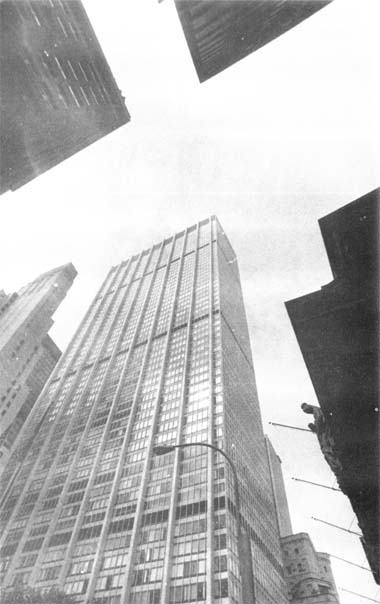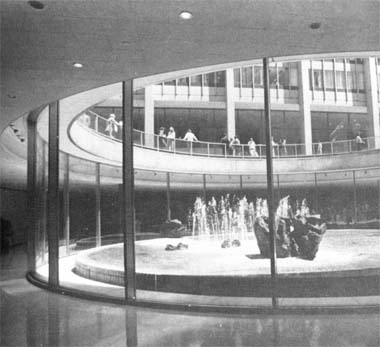 |
| The Chase Manhattan Bank Building. |
 |
| Sunken pool with sculpture by Isarnu Noguchi in Chase Manhattan Plaza. |
| Home | Tours/Lectures | Books | Maps | Posters | Pictures | Contact |
CHASE MANHATTAN PLAZA
Nassau and Cedar StreetsBecause of the narrow streets and the cluster of high buildings, the Chase Manhattan Building at the corner of Pine and William Streets strikes the beholder as stupendous. One gains a much greater sense of size here than, for example, from the twin towers of the World Trade Center which [were] higher and larger. The building, 1957-1961, is the work of Skidmore, Owings & Merrill, the designer of the firm being Gordon Bunshaft. (SOM, as it is commonly known, had its beginning in Chicago with the World's Fair of 1933.)
It is 64 floors high with 8 foot 10 inch ceilings, except for the Wall Street Club on the 60th floor. The inspiration for the building comes from the Franco-Swiss Le Corbusier; he was the architect who, in the 1920s, envisioned a high block set in a small open space. The emphasis of the design is on the mechanical.
During construction the job presented major difficulties due to the foundation. It descends 90 feet or five levels, and quicksand was encountered.
On the plaza to the southeast is a colossal artifact by the French painter Jean Dubuffet. This is a reflection of the kind of modern pictures and statues to be found in the building. Among those who chose the objects was the late Alfred H. Barr, Jr. who was the director of MOMA.
David Rockefeller served for many years as president and thenas chairman of the board of The Chase Manhattan Bank, N.A. The family's connection goes back to 1930. This branch of the Rockefeller family was traditionally allied with the Equitable Trust Company. John D. Jr. was the largest shareholder of Equitable and Winthrop W. Aldrich, his brother-in-law, was president. In 1930, it merged with the Chase National Bank and Aldrich became president there. Later, Chase merged with the Bank of Manhattan Company, originally founded in the 1800s as a water supply company with the right to engage in banking. For years the Chase Manhattan Bank, N.A. was the city's largest and the second largest in the nation.
The tour goes south to Wall Street, continues on Broad Street to Beaver, and then on to Broadway again, to stop at the north tip of Bowling Green at 26 Broadway.
 |
| The Chase Manhattan Bank Building. |
 |
| Sunken pool with sculpture by Isarnu Noguchi in Chase Manhattan Plaza. |